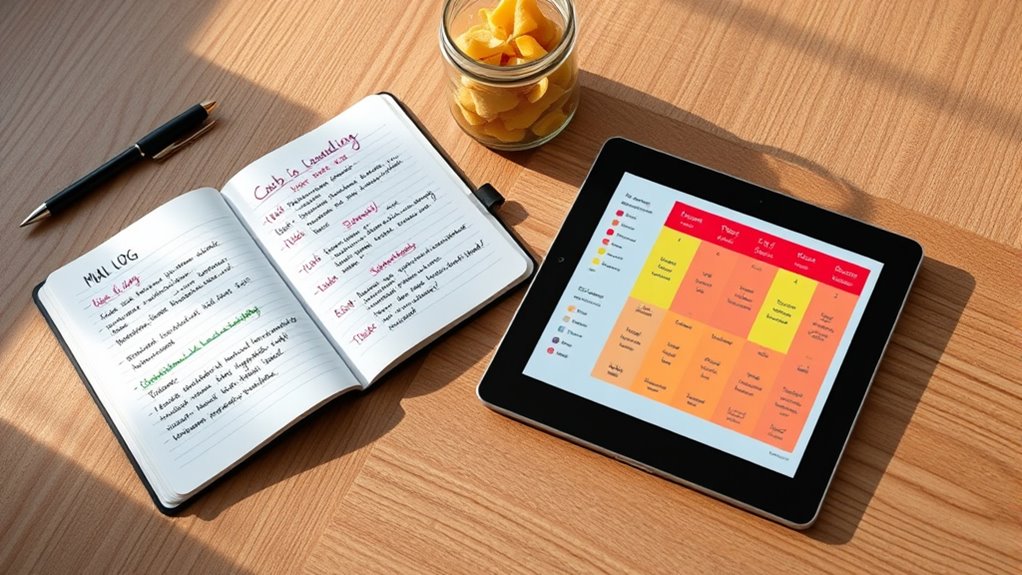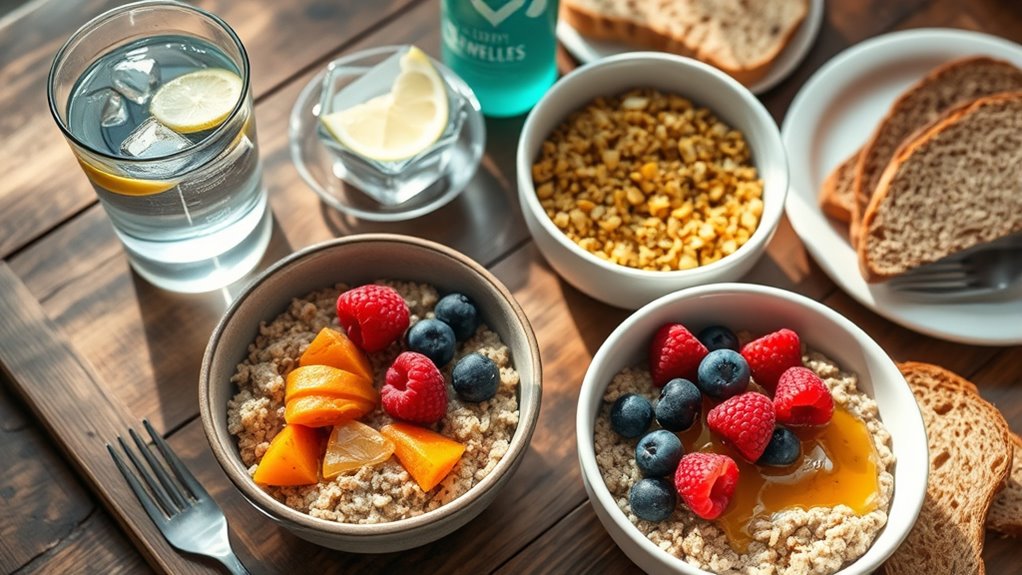To create a personalized carb-loading plan, assess your activity level and goals to determine your carbohydrate needs. Choose the right types and sources, focusing on complex carbs like fruits, vegetables, and whole grains, while supporting glycogen storage with proper nutrients. Calculate your storage capacity and plan your intake 3-4 days before your event, timing meals appropriately, and staying well hydrated. If you keep exploring, you’ll discover how to fine-tune your plan for peak performance.
Key Takeaways
- Assess your activity level, goals, and glycogen storage capacity to tailor carbohydrate intake and timing effectively.
- Select diverse, nutrient-rich carbohydrate sources, considering dietary restrictions and supporting recovery with vitamins, minerals, and antioxidants.
- Determine optimal meal timing before, during, and after workouts to maximize energy availability and glycogen replenishment.
- Monitor your body’s response to carbohydrate intake and adjust portions or timing for comfort, energy, and digestion.
- Incorporate hydration and electrolyte strategies alongside nutrition, personalizing them based on your individual needs and training demands.
Assess Your Activity Level and Goals

Before creating a personalized carb-loading plan, you need to evaluate your activity level and goals. Your activity level determines how much carbohydrate you’ll need to fuel your muscles effectively. If you’re engaging in high-intensity or long-duration exercise, you’ll require more carbs than someone with a moderate routine. Your goals also influence your plan—whether you’re aiming for endurance, recovery, or performance enhancement. Consider how meal timing plays a role; plan to consume carbs strategically before, during, and after workouts for ideal energy and recovery. Snack choices matter too—opt for easily digestible, nutrient-dense carbs that align with your activity schedule. Additionally, incorporating performance kits and suspension upgrades can optimize your body’s response to training, similar to how tuning a vehicle improves its overall performance. Understanding your fitness level can help you select the appropriate carbohydrate sources and portions, ensuring your plan is both effective and sustainable. Developing a creative approach to your carb intake, such as experimenting with different food combinations, can also help you discover what works best for your body. Incorporating proper storage techniques for your carbohydrate-rich foods can help maintain their freshness and nutritional value, ensuring consistent energy supply. By understanding your activity intensity and objectives, you can tailor your carb intake to maximize energy and support your training.
Understand Carbohydrate Types and Sources

Understanding the different types of carbohydrates and their sources is essential for optimizing your carb-loading plan. Carbohydrates come in two main categories: simple sugars and complex carbs. Simple sugars, found in foods like candies, honey, and sugary drinks, digest quickly and provide rapid energy. Complex carbs, from sources such as whole grains, legumes, and starchy vegetables, digest more slowly, offering sustained fuel. Fiber sources, present in fruits, vegetables, and whole grains, are a type of carbohydrate that aids digestion and helps regulate blood sugar levels. Incorporating a mix of these carbohydrate types ensures you get quick energy when needed and longer-lasting fuel. Additionally, including antioxidants in your diet can support overall health and recovery during intense training periods. Being mindful of glycogen storage strategies can further enhance your performance by maximizing energy reserves. Understanding how nutrient timing affects your carbohydrate intake can help you better plan your meals around training sessions. Knowing your sources allows you to tailor your intake to match your activity demands and optimize glycogen storage. Additionally, family photoshoot fails often include humorous moments that can help you stay relaxed and positive during your training.
Determine Your Glycogen Storage Needs

To plan your carb-loading effectively, you need to understand how much glycogen your body can store. Calculating your energy requirements helps determine the right amount of carbs to fuel your activity. Knowing these factors guarantees your plan boosts performance without overloading. Incorporating beneficial ingredients like collagen and hyaluronic acid can also support skin hydration during your routine. Additionally, understanding your individual metabolic rate can optimize your carbohydrate intake for better results.
Assess Glycogen Capacity
Determining your glycogen storage capacity is essential for creating an effective carb-loading plan. Your muscles and liver have specific limits on how much glycogen they can hold, influenced by factors like body size, muscle mass, and training level. To assess this, consider your overall storage capacity, which involves understanding how efficiently your body performs glycogen synthesis. Knowing these limits helps prevent unnecessary carbohydrate intake that won’t be stored, optimizing your plan. Keep in mind that individual differences mean your capacity may be higher or lower than average. By accurately estimating your storage capacity, you can tailor your carbohydrate consumption to maximize glycogen replenishment without overloading, ensuring you’re fully fueled for your activity.
Calculate Energy Requirements
Calculating your energy requirements helps you pinpoint exactly how much carbohydrate you need to maximize glycogen storage. Your metabolic rate influences how many calories your body burns at rest and during activity, shaping your overall energy balance. To determine your needs, start by estimating your basal metabolic rate (BMR), then factor in your activity levels to find your total daily energy expenditure. Knowing this total helps you understand how many calories you should consume to maintain, gain, or lose weight, which directly impacts your carbohydrate intake. Properly evaluating your energy requirements ensures you’re fueling your body appropriately without over- or under-consuming carbs. This targeted approach optimizes glycogen storage, so you’re ready for peak performance.
Calculate Your Daily Carbohydrate Intake

Understanding how many carbs you need each day is essential for an effective carb-loading plan. To optimize glycogen replenishment, you need to determine your daily carbohydrate intake based on your activity level and body weight. Generally, athletes aiming to maximize glycogen stores should consume about 7-10 grams of carbs per kilogram of body weight daily. Pay attention to carbohydrate timing — spreading your intake evenly throughout the day helps maintain steady energy levels and supports glycogen synthesis. Tracking your daily intake guarantees you’re meeting your targets without overdoing it, which can cause digestive discomfort or unnecessary weight gain. Adjustments might be necessary as your training intensity and goals evolve, but calculating your daily carbohydrate needs provides a solid foundation for your personalized plan.
Plan Your Carbohydrate Loading Phase

To effectively prepare your muscles for ideal performance, you need to carefully plan your carbohydrate loading phase. Focus on meal timing to maximize glycogen storage—start increasing carbs about 3 to 4 days before your event, spreading intake evenly throughout the day. Consider your dietary restrictions, choosing foods that fit your needs without causing discomfort. If you’re vegetarian, opt for grains and legumes; if gluten-sensitive, select gluten-free options like rice or potatoes. Avoid heavy, fatty foods that slow digestion. Prioritize consistent carbohydrate intake, and plan your meals so that your body gradually adapts without feeling overly full or sluggish. Proper planning guarantees your muscles are well-stocked with glycogen, giving you the energy boost needed for peak performance.
Monitor Your Response and Adjust Accordingly

As you implement your carbohydrate loading plan, pay close attention to how your body responds. Track your energy levels, digestion, and overall comfort during different meal times. Adjust your meal timing if you notice sluggishness or hunger between meals, making sure you’re fueling at suitable times. Observe how your body reacts to varying carbohydrate quantities and types, and tweak your nutrient timing accordingly. For example, if you feel sluggish late in the day, consider shifting carbohydrate intake to earlier meals. Consistently monitoring these responses helps you fine-tune your plan for maximum effectiveness. Remember, personalized adjustments based on your body’s signals ensure you’re not just following a plan, but creating one that works best for you.
Incorporate Supporting Nutrients and Hydration

Supporting nutrients and proper hydration play a crucial role in maximizing the effectiveness of your carbohydrate-loading plan. You should focus on nutrient timing by eating balanced meals that include vitamins, minerals, and healthy fats to support glycogen storage and recovery. Incorporate hydration strategies like drinking water regularly throughout the day, especially leading up to your event, to maintain ideal fluid levels. Electrolytes, such as sodium and potassium, are also essential to prevent cramping and ensure your muscles function efficiently. Avoid excessive dehydration or overhydration, which can impair performance. By combining proper nutrient timing with effective hydration strategies, you’ll enhance your energy reserves and set yourself up for a successful race or event.
Frequently Asked Questions
How Early Should I Start My Carb-Loading Plan Before an Event?
You should start your carb-loading plan about 3 to 4 days before your event. This timing strategy helps maximize glycogen stores without causing discomfort. Focus on incorporating quality carbohydrate sources like pasta, rice, and bread into your meals. By gradually increasing your intake and paying attention to how your body responds, you’ll optimize your energy levels and performance on race day.
Can Vegetarians or Vegans Effectively Carb-Load?
Ever wonder if vegetarians or vegans can carb-load effectively? The answer is yes, but it’s all about choosing the right plant-based alternatives and timing your nutrient intake. By focusing on foods like pasta, bread, rice, and starchy vegetables, and planning your meals around your activity, you access optimal glycogen stores. Proper nutrient timing ensures your body absorbs carbs efficiently, giving you the energy boost you need for peak performance.
What Are Common Mistakes to Avoid During Carb-Loading?
When carb-loading, avoid common mistakes like overeating carbohydrates, which can cause stomach discomfort or fatigue, and neglecting hydration, leading to cramping or reduced performance. You might be tempted to load up on high-sugar foods, but focus on complex carbs instead. Stay balanced, drink enough water, and listen to your body’s signals. This guarantees you maximize glycogen stores without adverse effects, boosting your endurance on race day.
How Do I Balance Carbs With Protein and Fats in My Plan?
To balance carbs with protein and fats, focus on macronutrient ratios that support your activity level and goals. Incorporate moderate protein to aid recovery and healthy fats for sustained energy. Pay attention to meal timing, spreading your intake evenly throughout the day to optimize digestion and energy. Adjust these ratios based on how your body responds, ensuring you feel energized without feeling overly full or sluggish.
Is It Safe to Carb-Load if I Have Dietary Restrictions or Health Conditions?
Ever wondered if carb-loading is safe with dietary restrictions or health conditions? You should verify with your healthcare provider first, especially if you have diabetes, kidney issues, or food allergies. While carb-loading can boost energy, it may worsen certain conditions or conflict with restrictions. Always personalize your plan and get professional advice to ensure you’re fueling your body safely without risking health complications.
Conclusion
Your personalized carb-loading plan is like planting seeds for your victory. Nurture it with knowledge and care, and watch your energy blossom on race day. Trust in the process, stay adaptable, and honor your body’s unique needs. Remember, each carbohydrate choice is a step toward your peak performance—your own shining star guiding you through the marathon of your goals. Embrace this journey, and let your preparation illuminate your path to success.








